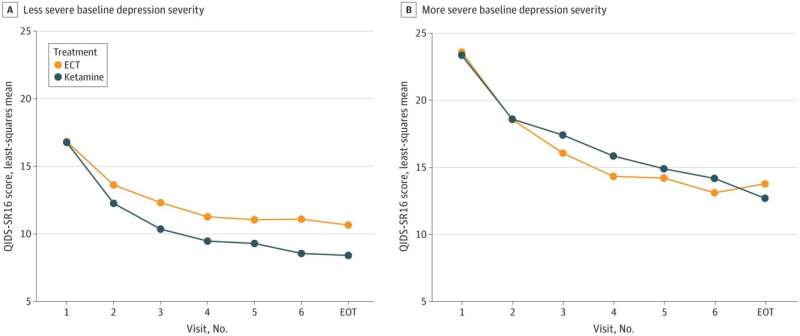This article has been reviewed according to Science X's editorial process and policies. Editors have highlighted the following attributes while ensuring the content's credibility:
fact-checked
peer-reviewed publication
trusted source
proofread
Electroconvulsive therapy or ketamine? Clinical factors affect outcomes

Patients with moderate to severe treatment-resistant depression (TRD) might have better symptom relief from ketamine infusions than from electroconvulsive therapy (ECT), but those with severe TRD could benefit more from ECT early in treatment, an analysis led by a UT Southwestern Medical Center researcher shows.
The findings, published in JAMA Network Open, are the first to identify characteristics that distinguish which treatments might benefit TRD patients more.
"Patients with TRD and their physicians can incorporate these findings in their shared decision-making process when selecting between ketamine and ECT," said first author Manish Jha, M.D., associate professor of psychiatry and an O'Donnell Clinical Neuroscience Scholar at UT Southwestern. Dr. Jha is also an investigator in the Peter O'Donnell Jr. Brain Institute.
Previous studies have suggested that up to a third of adults with major depressive disorder have TRD, meaning they haven't experienced adequate improvement with two or more courses of antidepressants.
For decades, doctors have treated TRD patients with ECT, which delivers a jolt of electricity to the brain. More recently, ketamine—a drug historically used as an anesthetic—has also been used to treat TRD.
In a study known as the ELEKT-D clinical trial that published last year in the New England Journal of Medicine and was led by Amit Anand, M.D., Professor of Psychiatry at Harvard Medical School, Dr. Jha and his colleagues showed that ECT and ketamine produced comparable results in a group of 403 patients with TRD at five U.S. medical centers.
However, it was unclear whether patients' baseline characteristics could predict which would be more beneficial.
So Dr. Jha and research colleagues across the U.S. analyzed ELEKT-D's results in a subgroup of 365 patients—195 had received up to six ketamine infusions over three weeks, and 170 had received up to nine ECT treatments over three weeks. Twice weekly during the treatment phase and at one follow-up after their treatments ended, these patients filled out a questionnaire designed to assess their depression symptoms.
The questionnaire was developed by former UTSW physician-researcher A. John Rush, M.D., Professor Emeritus at the Duke-NUS Medical School at the National University of Singapore, and Madhukar Trivedi, M.D., Professor of Psychiatry, Chief of the Division of Mood Disorders, and founding Director of the Center for Depression Research and Clinical Care at UT Southwestern.
The patients also were assessed with a clinician-administered diagnostic tool. In addition, they underwent evaluations assessing various demographic and clinical characteristics, such as age, sex, concurrent use of other treatments, cognitive function, and whether they were being treated for their depression as an inpatient or outpatient.
When the researchers compared the patients' symptom assessments over three weeks with their demographic and clinical characteristics, they found that patients were most likely to benefit from ketamine if they had moderate to severe overall depression at baseline or were receiving treatments as outpatients.
Patients with very severe depression or who received their treatments as inpatients had more benefit early in their treatment course from ECT. However, by their last appointment, patients with these characteristics who received ketamine had similar outcomes.
Dr. Jha noted that a variety of factors go into deciding which treatment is the best fit for patients with TRD, including whether they can conveniently access the treatment, if insurance will cover it, and possible side effects. The findings from this analysis add another factor that patients and doctors can consider when choosing the best option, he said.
More information: Manish Kumar Jha et al, Ketamine vs Electroconvulsive Therapy for Treatment-Resistant Depression, JAMA Network Open (2024). DOI: 10.1001/jamanetworkopen.2024.17786





















